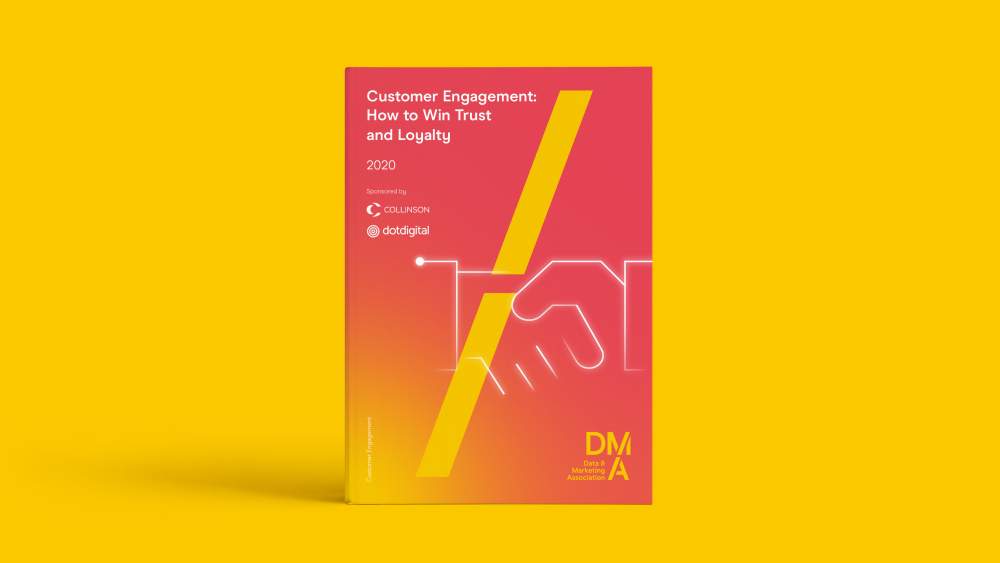Customer Engagement 2020: An Overview
05 Mar 2021

Our Customer Engagement 2020 event shared research case studies, debates, and views of the future.
Scott Logie, Chair of the DMA Customer Engagement Committee and Director of Data and Insight at REaD Group, introduced the summit.
The day explored the launch of this year's customer loyalty research; how brand loyalty has changed; channel strategies for retention and long-term engagement; motivating the future customer through identity, loyalty, and sharing; thoughtful marketing as a driver for brand choice; and the future of customer engagement.
How to Win Trust and Loyalty
Tim Bond, Head of Insight, DMA gave an overview of our 2020 customer loyalty research report, highlighting some of the key behavioural shifts and attitudes emerging from the current climate and, as a result, how brands should engage their customers.

As periods of lockdown and social distancing have become part of our daily lives, he said, consumers have had to turn to digital channels to maintain daily essential communications:
- Almost half of consumers are making video calls weekly
- One in 10 consumers have video called a brand
- Half of consumers have used some kind of chat customer service
While digital engagement with brands is more practical and needed for consumers during the coronavirus, Tim said it’s expected that the experiences of living through this period will increase consumers’ willingness to engage with brands remotely in the future.
What do consumers expect brands to communicate during the pandemic?
- The majority (77%) expect brands to show customers compassion
- The minority (22%) feel they receive too much communication about the coronavirus from brands
This suggests that more consumers want brands to engage with them directly about the pandemic and explicitly show their compassion; other data suggests that compassion is best shown through action rather than sentiments alone.
What should brands specifically communicate during this time?
- Participants were more likely to rank practical support for customers and staff as important – even more than getting discounts and promotions
- Two thirds (66%) wanted brands to tell them what they're doing to help customers
- 59% wanted brands to tell them how they're keeping staff safe
Consumer loyalty
- 51% of consumers are still ‘Active Loyals’ and one in five are still ‘Active Disloyals’ (remaining consistent with DMA research in recent years)
This stability, even under the stresses of the coronavirus, reminds us that consumers crave consistency from the brands they engage with.
Favourite brands
- A significant proportion of consumers didn’t feel they had one brand they were loyal to
- In 2020, functional drivers remained ubiquitous and underpinned loyalty for almost all consumers
- Personal and societal compassion alongside brand charisma have grown in importance
As it becomes harder for brands to differentiate themselves based on functional excellence – for example, payment options and efficient delivery mechanisms – it will be these additional pillars that make them truly stand out.
How do UK consumers receive loyalty mechanisms?
- Supermarkets, retail, and travel loyalty are most popular as people increase in age
- Younger generations are more likely to use loyalty schemes with finance, media, entertainment, and technology brands
- Millennials and Gen Z are leading the way on the usage of paid loyalty
- The value of benefits and rewards is declining for consumers
So, how can brands optimise loyalty strategies?
By asking consumers about the different types of benefits they receive and the ones they would like to receive, Tim said, we could identify the reward strategies that are appealing to consumers but aren’t being delivered.
How do consumers prefer to receive marketing from brands they know?
- Seven in 10 consumers prefer email
- Six in 10 trust email marketing
- Two thirds perceive emails as relevant
Tim wrapped up his presentation by saying that although this year's findings show the core principles of trust and loyalty haven’t changed as much as we may have thought, the coronavirus has accelerated many key trends, such as digital-first brand engagement and subscriptions.
Download the full report, here.
Brand Loyalty in 2020 – how has it changed and what learnings can we take into the new normal?
Next up was the first panel discussion of the event alongside:
- Guy Thornton, Head of Loyalty, News UK
- Sophie Handley, Head of Customer Marketing, Brittany Ferries
- Marie Feliho, Global Head of Customer Retention, Just Eat
- Rob McDonald, Chief Commercial Officer, IAG Loyalty
The debate began with Scott Logie asking these experts what stood out in the 2020 customer loyalty research report.
Guy said that finding out 89% of people called out functional needs in terms of loyalty made him realise loyalty isn't a function in a marketing team: it needs to be the whole essence of the brand – how that business behaves, builds its products, markets itself, and so on.
For Marie, it was that the principles of loyalty haven't changed that much. At the end of the day, she said, customer experiences and what the business gives back remains the most important thing. “Having a loyalty programme is the cherry on the cake,” she said, “but if the rest of those pillars aren’t well delivered, then a loyalty programme itself might not be what saves you.”
Sophie pointed out that the decline in customers seeing a value of the benefits from reward programmes shows that, now more than ever, the brand’s role around loyalty needs to shift and be based on understanding customers and their values.

Rob said that he was interested in different generations having different expectations. There’s a lot of dialogue around how younger customers prefer experiences rather than tangible product giveaways, he explained.
Over the last few years, we’ve seen the trend of brands generating loyalty through vastly better digital experiences. “I believe that to be very true,” he said, “but because digital means faster, you see a lack of levelling up.” Multiple brands end up doing something similar, because they get as good as possible while the technology allows. “Rewards programmes still have a very strong point of differentiation.”
The discussion also included panellists’ views on whether brands think about their functional requirements before building loyalty; if customers have changed how they engage with brands that, due to the pandemic, can’t offer the same functionality as before but offer compassion; and if there’s another side to loyalty in which consumers are trying to be committed to brands.
To hear the full debate, head here.
Channel Strategies for Retention and Long-Term Engagement
The second panel discussion featured:
- Nick Fletcher, Head of Planning and Strategy, Collinson
- Gavin Laugenie, Head of Strategy and Insight, dotdigital
- Kerensa Ayivor, Planning Director, TLC Marketing
- Grace Francis, Chief Experience Officer, Karmarama
Scott asked the panellists if they think people buy from brands because they express a purpose, help them solve a problem, or both.
Grace said that we’ve started to see a shift in what brand purpose means. Brands need to have a space in the world stage, she explained. How they show that accountability, not only to the individual user but to their employees and wider society, has become our benchmark. “It's not enough anymore just to have it in your comms,” she said.

What role does email have in demonstrating that brand compassion? Do you see examples of this in the work you do? Scott asked.
“I don't see enough examples of it,” Gavin said. Brands can go a lot further in using the channel to make a connection with their audiences. Far too often businesses use a sales vibe in their emails and don’t use the data they collect, he explained. Through taking the time to make this connection, brands will see ROI come through and people become more loyal.
Kerensa added that sometimes brands are so overloaded with how much data is out there. How does data become something that doesn't only describe people, but actually tells you what’s important to them? What messaging do we need to reach out and engage them?
Gavin said that it's important to use more than one piece of data. “It's like building up a digital body language of someone,” he said. When you fuse together implicit and explicit data, you get a better makeup of that person and can treat them as an individual.
Nick agreed, saying that to understand people, we need to actually talk to them. Combining behavioural and hard data is really important, he said.
The discussion also covered panellists’ thoughts on the research report and whether brands are using video more to build engagement. Listen to the rest of the debate, here.
Identity, Loyalty, and Sharing – Driving the Future Customer
Charles Ping, Managing Director, Winterberry Group gave a presentation on the forces changing customer understanding, activation, and evaluation; what the future may hold; and what marketers need to tackle in early 2021.
He began by saying that identity isn’t data: data is a component that builds identity.

The critical factors driving the landscape today, he explained, are:
- Explosion in the number of addressable devices
- Planned deprecation of third-party cookies
- Recognition of identity solutions as a key marketing/advertising tool
- Significant adoption of video consumption
- Difficulty of measurement and attribution
- Efforts by media owners to rebalance control against programmatic trading providers
The net effect of these factors, Charles said, is the relentless focus on first-party data, and the rights that come with it. First-party data sits at the intersection of the three ecosystems where identity is used: programmatic (paid digital media), personalisation (on owned), and advanced TV (addressable, CTV, and OTT), he explained.
He outlined the identity solutions that don’t rely on the third-party cookie:
- A propriety ID based on authenticated first-party data
- A common ID based on a first-party data match to a personal data-based reference data set
- A second-party data environment
- Contextual targeting
First-party solutions supplemented by collaborative arrangements will dominate, he said, and they’re driven by:
- Importance of first-party data collection
- Accelerated adoption of customer-data solutions
- Improved analytical integration for insights and optimisation
- Advanced decisioning, orchestration, and customer-journey management
The media world, he continued, is going to look very different through:
- Walled gardens (characterised as impenetrable like Google and Amazon)
- Private gardens (large enterprise entities that have a lot of data and frequency of visit but are more collaborative like Disney and Tesco)
- Communal gardens (alliances built to create reach, frequency, and scale where each individual contributor doesn't necessarily have it like netID)
- Rolling hills (where media can't gather data, because the type of engagement isn't right)
Charles went on to talk about the eight forces driving collaboration:
- Consumer privacy
- Security
- Compliance
- Identity anonymity
- Need for scale/reach above and beyond first-party data
- Visibility into the customer journey for attribution, measurement
- Enhanced ability to collaborate directly with partners
- Enhanced ability to collaborate across the enterprise and its data silos
He wrapped up his presentation with six trends to watch for:
- Focus on scaling first-party data collection and identifying graph creation
- Increased difficulty conducting measurement and attribution efforts
- Growth of cohort learning and contextual targeting
- Focus on improving internal talent in data, identity, and collaboration
- Pause on many in-housing efforts due to increased complexity
- Cooperation and flexibility on salutation approaches
See his full presentation, here.
Thoughtful Marketing: A Driver for Brand Choice

Next, Marisa Thomas, Head of Brand, Bloom & Wild and Sarah House, Head of CRM & Multi Channel Marketing, Paperchase discussed how they’ve experienced thoughtful marketing over the last year, what they’ve done to push it forward, and how it can help businesses.
Marisa started by putting out the statement “people don’t often say what they’re thinking.” A great example is email marketing, she explained, and how we continue to overwhelm our customers’ inboxes with messages, but we don't necessarily interrogate beyond converting to find out if customers like what’s said. This can lead to a group of customers silently feeling put off by your communications.
As a very data-led business, Bloom & Wild became more thoughtful to see their customers’ point of view. Thoughtful marketing began with offering opt outs at sensitive occasions, Marisa said, but the pandemic has spiralled the movement and pivoted this original approach into how businesses can retain loyal customers who might not be able to purchase with them at the moment.
“Thoughtfulness isn’t a one-off campaign,” she said. “It’s a pillar that helps you build better connections with your customers. And this helps you find ways to stay relevant and front of mind, whether they’re shopping with you or not.”
Marissa passed on the discussion to Sarah from Paperchase, who joined the thoughtful marketing movement in 2020. “As marketers, it’s a little bit upside down to think about asking people what they don't want to hear about, rather than what they do,” Sarah said.
However, positive social responses from giving customers the option to opt out of Mothers’ Day communications showed that thoughtfulness is a really emotive topic. Not only does it make your brand stand out, she said, but it makes your customers feel appreciated and understood.
This is something we were doing pre-pandemic, she explained, such as with their pledge wall at the Fearne Cotton’s Happy Place Festival, where people could write down positive affirmations. However, when their stores closed, Paperchase needed to think differently. Here’s some ways they spread positivity and increased engagement:
- A pub quiz every Friday on their Instagram stories
- A social distancing birthday bingo card sent out in birthday emails and available for download on their blog
- Positive slogans people could save on their phones or send to a friend every Wednesday on their social
Find out more actionable ideas and listen to the rest of Sarah and Marissa’s discussion, here, including advice for brands looking to create more thoughtful content.
The Future of Customer Engagement
Josh McBain, Director of Consultancy, Foresight Factory tied up the day with his presentation on the trends that have accelerated due to the pandemic.
Drawing on the expertise of partners at Oxford Economics, Josh dissected four key trends that he thinks are the most important within the future of customer engagement:
- Building resilience – consumers crave personal confidence in uncertain situations
- Presence-free living – the need to be physically present to work, shop, and communicate is being challenging by digital and cultural change
- Data as currency – personal data is no longer an unknown entity but a valuable commodity to be traded and kept safe
- All inclusive – consumers expect brands to recognise their diversity – both as individuals and as communities
Get a detailed overview of each trend, including why they’ve become more significant due to the coronavirus, and what their medium-term impact is likely to be.
Closing remarks from Chair Scott Logie wrapped up the event.
A special thank you to our sponsors Collinson and dotdigital, our speakers, as well as our attendees.
Find out more about the DMA’s Customer Engagement campaign, here.
See our upcoming Customer Engagement events, here.